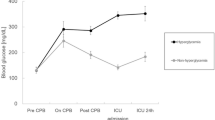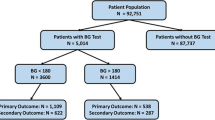Abstract
The objective of this study was to determine the prevalence of postoperative hyperglycemia in pediatric patients following surgery for congenital cardiac defects and its impact on morbidity and mortality. It was designed as a retrospective cohort study in a pediatric intensive care unit of a university-affiliated free-standing children’s hospital. A cohort of 213 patients who underwent 237 surgical procedures for repair or palliation of congenital cardiac defects comprised the study. Postoperative blood glucose measurements and all clinical and laboratory data were compiled for the first 10 days after surgery. The intensity and duration of hyperglycemia were analyzed for association with hospital morbidities and mortality. Mild and severe hyperglycemia were highly prevalent in our cohort (97% and 78%, respectively). Survivors had significantly lower peak (289.7 ± 180.77 mg/dl vs. 386 ± 147.95 mg/dl), mean (110.13 ± 36.22 mg/dl vs. 146.75 ± 57.12 mg/dl), and duration (2.59 ± 2.3 days vs. 5.35 ± 2.8 days) of hyperglycemia compared to nonsurvivors. Duration of hyperglycemia was independently associated with morbidity [odds ratio (OR): 1.95; p < 0.001] and mortality (OR: 1.41; p = 0.03) by multivariate logistic regression. Hyperglycemia is common in children following surgical repair or palliation of congenital cardiac defects. Postoperative hyperglycemia is associated with increased morbidity and mortality in these patients.


Similar content being viewed by others
References
American Diabetes Association (2005) Diagnosis and classification of diabetes mellitus. Diabetes Care 28(Suppl 1):S37–S42
Bochicchio GV, Sung J, Joshi M, Bochicchio K, Johnson SB, Meyer W, Scalea TM (2005) Persistent hyperglycemia is predictive of outcome in critically ill trauma patients. J Trauma 58:921–924
Branco RG, Garcia PC, Piva JP, Casartelli CH, Seibel V, Tasker RC (2005) Glucose level and risk of mortality in pediatric septic shock. Pediatr Crit Care Med 6:470–472
Butler SO, Btaiche IF, Alaniz C (2005) Relationship between hyperglycemia and infection in critically ill patients. Pharmacotherapy 25:963–976
Cai L, Li W, Wang G, Guo L, Jiang Y, Kang YJ (2002) Hyperglycemia-induced apoptosis in mouse myocardium: mitochondrial cytochrome C-mediated caspase-3 activation pathway. Diabetes 51:1938–1948
Ceriello A, Quagliaro L, D’Amico M, et al. (2002) Acute hyperglycemia induces nitrotyrosine formation and apoptosis in perfused heart from rat. Diabetes 51:1076–1082
Cochran A, Scaife ER, Hansen KW, Downey EC (2003) Hyperglycemia and outcomes from pediatric traumatic brain injury. J Trauma 55:1035–1038
de Ferranti S, Gauvreau K, Hickey PR, et al. (2004) Intraoperative hyperglycemia during infant cardiac surgery is not associated with adverse neurodevelopmental outcomes at 1, 4, and 8 years. Anesthesiology 100:1345–1352
Dietrich WD, Alonso O, Busto R (1993) Moderate hyperglycemia worsens acute blood-brain barrier injury after forebrain ischemia in rats. Stroke 24:111–116
DiPette DJ, Ward-Hartley KA, Jain RK (1986) Effect of glucose on systemic hemodynamics and blood flow rate in normal and tumor tissues in rats. Cancer Res 46:6299–6304
Faustino EV, Apkon M (2005) Persistent hyperglycemia in critically ill children. J Pediatr 146:30–34
Gore DC, Chinkes D, Heggers J, Herndon DN, Wolf SE, Desai M (2001) Association of hyperglycemia with increased mortality after severe burn injury. J Trauma 51:540–544
Gu W, Pagel PS, Warltier DC, Kersten JR (2003) Modifying cardiovascular risk in diabetes mellitus. Anesthesiology 98:774–779
Hall NJ, Peters M, Eaton S, Pierro A (2004) Hyperglycemia is associated with increased morbidity and mortality rates in neonates with necrotizing enterocolitis. J Pediatr Surg 39:898–901
Jenkins KJ, Gauvreau K, Newburger JW, Spray TL, Moller JH, Iezzoni LI (2002) Consensus-based method for risk adjustment for surgery for congenital heart disease. J Thorac Cardiovasc Surg 123:110–118
Kang BP, Frencher S, Reddy V, Kessler A, Malhotra A, Meggs LG (2003) High glucose promotes mesangial cell apoptosis by oxidant-dependent mechanism. Am J Physiol Renal Physiol 284:F455–F466
Kersten JR, Toller WG, Gross ER, Pagel PS, Warltier DC (2000) Diabetes abolishes ischemic preconditioning: role of glucose, insulin, and osmolality. Am J Physiol Heart Circ Physiol 278:H1218–H1224
Kersten JR, Warltier DC, Pagel PS (2005) Aggressive control of intraoperative blood glucose concentration: a shifting paradigm? Anesthesiology 103:677–678
Krinsley JS (2003) Association between hyperglycemia and increased hospital mortality in a heterogeneous population of critically ill patients. Mayo Clin Proc 78:1471–1478
McCowen KC, Malhotra A, Bistrian BR (2001) Stress-induced hyperglycemia. Crit Care Clin 17:107–124
Mizock BA (1995) Alterations in carbohydrate metabolism during stress: a review of the literature. Am J Med 98:75–84
Ouattara A, Lecomte P, Le Manach Y, et al. (2005) Poor intraoperative blood glucose control is associated with a worsened hospital outcome after cardiac surgery in diabetic patients. Anesthesiology 103:687–694
Pulsinelli WA, Waldman S, Rawlinson D, Plum F (1982) Moderate hyperglycemia augments ischemic brain damage: a neuropathologic study in the rat. Neurology 32:1239–1246
Srinivasan V, Spinella PC, Drott HR, Roth CL, Helfaer MA, Nadkarni V (2004) Association of timing, duration, and intensity of hyperglycemia with intensive care unit mortality in critically ill children. Pediatr Crit Care Med 5:329–336
Sung J, Bochicchio GV, Joshi M, Bochicchio K, Tracy K, Scalea TM (2005) Admission hyperglycemia is predictive of outcome in critically ill trauma patients. J Trauma 59:80–83
Turina M, Fry DE, Polk HC Jr. (2005) Acute hyperglycemia and the innate immune system: clinical, cellular, and molecular aspects. Crit Care Med 33:1624–1633
van den Berghe G, Wouters P, Weekers F, et al. (2001) Intensive insulin therapy in the critically ill patients. N Engl J Med 345:1359–1367
Van den Berghe G, Wouters PJ, Bouillon R, et al. (2003) Outcome benefit of intensive insulin therapy in the critically ill: Insulin dose versus glycemic control. Crit Care Med 31:359–366
Van den Berghe G, Wilmer A, Hermans G, et al. (2006) Intensive insulin therapy in the medical ICU. N Engl J Med 354:449–461
Wernovsky G, Wypij D, Jonas RA, et al. (1995) Postoperative course and hemodynamic profile after the arterial switch operation in neonates and infants. A comparison of low-flow cardiopulmonary bypass and circulatory arrest. Circulation 92:2226–2235
Wintergerst KA, Buckingham B, Gandrud L, Wong BJ, Kache S, Wilson DM (2006) Association of hypoglycemia, hyperglycemia, and glucose variability with morbidity and death in the pediatric intensive care unit. Pediatrics 118:173–179
Yates AR, Dyke PC 2nd, Taeed R, Hoffman TM, Hayes J, Feltes TF, Cua CL (2006) Hyperglycemia is a marker for poor outcome in the postoperative pediatric cardiac patient. Pediatr Crit Care Med 7:351–355
Author information
Authors and Affiliations
Corresponding author
Rights and permissions
About this article
Cite this article
Falcao, G., Ulate, K., Kouzekanani, K. et al. Impact of Postoperative Hyperglycemia following Surgical Repair of Congenital Cardiac Defects. Pediatr Cardiol 29, 628–636 (2008). https://doi.org/10.1007/s00246-007-9178-8
Received:
Revised:
Accepted:
Published:
Issue Date:
DOI: https://doi.org/10.1007/s00246-007-9178-8




